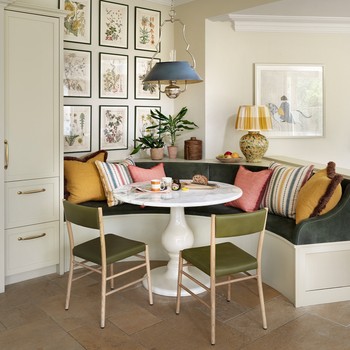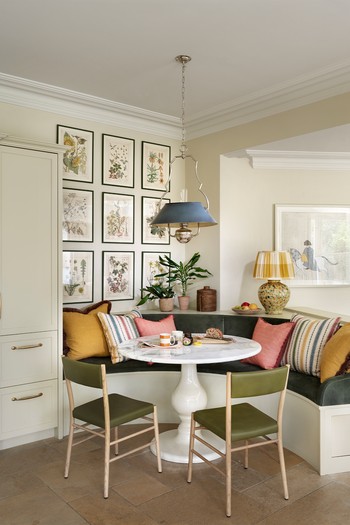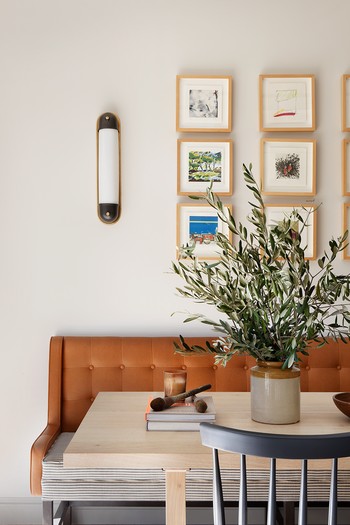An Expert’s Guide To Banquette Seating
What is the advantage of a banquette over a free-standing table and chairs?
“First, space. Unlike a coffee table that we can easily move around, a dining table and chairs need a little more room. One of my biggest pet peeves is seeing a dining table and chairs pushed up close against a wall. A good kitchen/diner is only as good as the sum of its parts, and if the overall balance is off because you chose a bigger island over a dining table, it will forever look like you’re eating at the table you put out for the kids at Christmas. In other words, temporary.
“Instead, the permanent nature of a banquette can create a focal point or balance point within a room that may otherwise feel a little rudderless without. Building in a banquette seat, and permanently fixing the location of the dining table in an open-plan room not only implies intention but it eliminates the issue of thoroughfare on one side of the dining table. It effectively buys you an extra metre in the room, if not more, and that space might very well be the thing standing in the way of making everything else work.
“Finally, it’s the perfect way to diversify the materials and finishes as you don’t need to have eight of the same dining chairs or mismatched dining chairs to achieve that diversity.”
If you want a standard against-the-wall design, where should you start?
“In this situation, the biggest decision is actually the type of table, and in particular the type of leg on the table. A table with a leg in each corner makes a banquette quite impractical as it affects the ‘seated shimmy’ one needs to do to get in and out. So, for an against-the-wall design, it’s better to go for a table with a central leg or a pedestal style table to free up the ends and corners. Also, try to extend the length of the banquette past the table by at least 400mm on both sides so people can be seated before they need to shimmy.”
What are the optimum dimensions for the seating – and how high should the table be?
“Typically, all dining tables are around 750mm high. Unlike desks, dining tables don’t have drawers underneath, so unless the dining table itself is a massive chunk of wood, the leg height below shouldn’t be too impeded. As a general rule of thumb, I keep my seat height at 450mm, and work from there if I’m having a loose seat cushion, fixed, sprung etc. You also want your table to over sail your banquette seat by around a third, so you don’t feel like you’re a mile from the table when you’re seated.”
If you are considering a corner banquette, what do you need to think about?
“When it comes to a corner banquette, you do need to think about access and how practical it actually is, especially if your dining table is an everyday, all aboard type of dining table. In most instances, a successful corner banquette tends to be a breakfast nook rather than a proper dining table, as the vibe tends to be a little more informal.”
What are some of the best materials?
“I always try to include at least two different finishes on any item, and it’s no different with a banquette. Also, these things aren’t small, so keep it interesting. If in doubt go for different fabrics on your seat and back, then keep the base or leg detail in a wood or painted finish. You can then layer in cushions, although I often choose not to have loose cushions (like scatters) as they might be good for a picture, but they’re really a pain to keep manoeuvring and plumping. Remember, a banquette seat is basically a long skinny sofa, so 90% of the time I opt for a sprung seat with a foam inner. Firm, but it fights back.”
Should you always have a back rest?
“If you can, then do it. I find a banquette seat without a back looks a little unfinished and perhaps more outdoor than indoor. Having loose back cushions is fine, but these do take a bit of work to keep in place, especially if there is regular movement.”
If you do decide to add cushions, do you need a deeper seat?
“I’ve found that a 450mm seat depth is always good, so ensure that this dimension is always maintained if you are using a fixed back or loose cushion. If you plan on adding lots of loose cushions, allow for an additional 100mm, but you could potentially get away with around 80-100mm if the seat was fixed. Scatter cushions need more depth as they take up more surface area, so if space is a concern, opt for a fixed back as these aren’t as deep.”
What about bolsters to divide each seat – good or bad idea?
“A slight arm on the banquette yes, bolsters no – they just become quite cumbersome. I generally tend to avoid loose cushions altogether.”
Can you have a round or curved banquette? How and where would that work best?
“I think it sightly kills the debate about a banquette being a space-saving option, and probably lends itself better to a breakfast nook or restaurant-style set up, but they can work. I would definitely say the banquette and table need to be designed as one and follow the same curve if possible. It’s a slightly more calculated option than simply pairing a table with the seat.”
What's the best way to treat the space underneath the seating?
“If you can add in some storage, then go for it. A solid base is one less set of legs to worry about, and the reality is that getting under the legs of a banquette for cleaning probably isn’t the easiest. It’s a toss-up between a drawer or a lift-up seat being more practical – what you store under a banquette seat probably wouldn’t be anything you need daily, so it’s not that much of an issue if and when you need to get under there. Personally, I prefer drawers as they can be smaller compartments accessed individually, rather than lifting up a huge section of seat. But I would say avoid drawers with push-to-open mechanisms; these become highly annoying when someone sat on the banquette opens them accidentally with their leg.”
Finally, does how you light the space matter?
“I’ve done pendants, spots and wall lights across a number of banquette projects. I would always advise thinking about the projection of a wall light, so you don’t bump your head on the way out. Keep them flat to the wall. Pendant-wise, you can be a little more relaxed (like with any dining table) – just bear in mind you’re less likely to hit your head if the pendant is centred over the table.”
Visit ChristianBense.com for more.
DISCLAIMER: We endeavour to always credit the correct original source of every image we use. If you think a credit may be incorrect, please contact us at info@sheerluxe.com.



